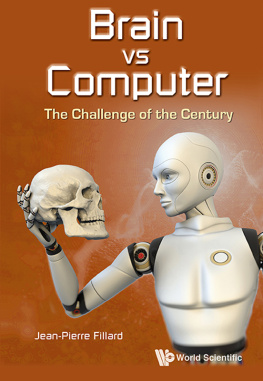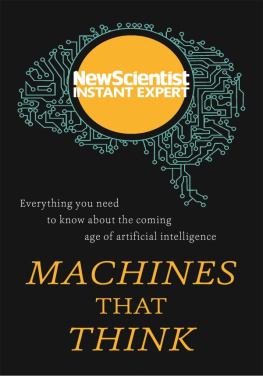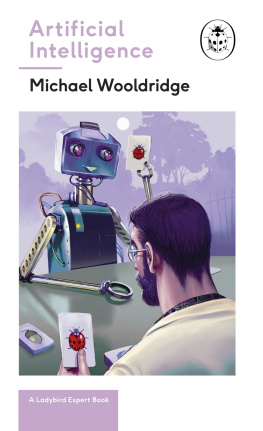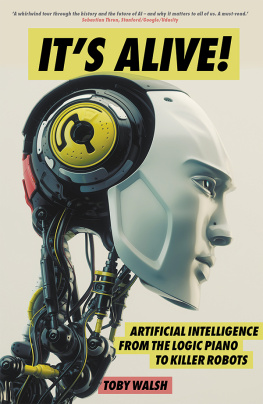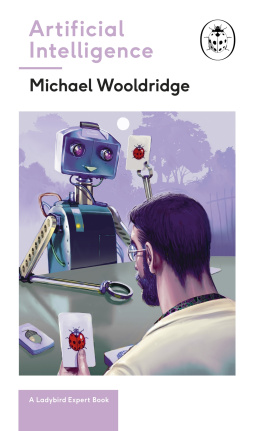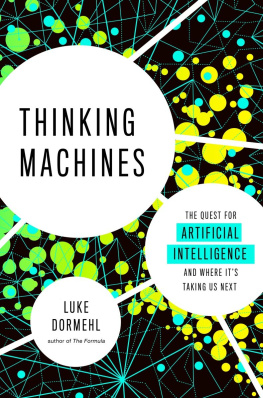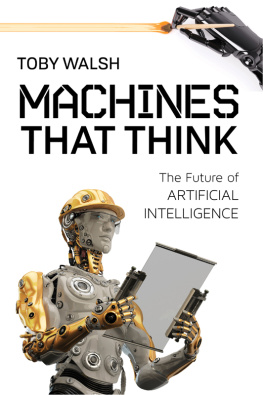
Chapter 1
The Biological Hardware
(Hardmeat)
R.U. Sirius (Ken Goffman) wisely uses the word hardmeat to refer to the (soft) biological hardware which backs the brains activity, and softmeat to refer to the way our brain is programmed to exchange and process information.
Of course, understanding the hard part of our brain is a tremendous task, but to make a copy also requires deciphering in depth how it works, i.e. the soft part, and that is not for tomorrow.
What About the Brain?
This part of the book is not intended to be an academic course about the neurology of the brain but, more simply, to assemble some indications, some elements of knowledge which could assist the reader in following the twists and turns of the match between the human brain and the computer. However, one cannot avoid asking this central, inescapable question: In this competition, does the computer have to truly mimic the brain, or would it not be better to let it develop its own skills by itself, without the aim of copying the brain?
The brain, as we all know, is encased in a bone box we call the skull, which protects it from external shocks; but this precious and delicate organ has, in addition, to be kept far from direct contact with the bone wall. This is the role of the meninges membranes which gently wrap the brain and act as a damping protection also with the intermembrane liquids. With all this careful packaging, the brain is ready to do its fantastic and unfathomable job.
The size of the brain is in the range of a liter or so and it weighs, as stated by Barck Obama himself, some three pounds. Then is all said about this box which houses our self, our soul (?), our personality? Humph! Far from it!
Some people thought that our intelligence (to start with this word which we will meet all along this book), or our cleverness if you have better, is directly related to the size and shape of our skull. Roughly, the rule was: The larger the better! This assumption gave rise to a wealth of attempts at finding correlations also with the complexity of the structured external shape of the brain in the framework of a science known as phrenology. Of course, we get the information after the brain has been removed, and then not any conformity check of the intelligence can be undertaken afterward!
This approach was also tentatively proposed for detecting criminal birth trends. It was later generally agreed that all of that comes to nothing. The mystery of our brains shape and size persists.
It must also be said that in that time the only available experimental means were reduced to visual examination. From the prehistoric ages men were curious about what goes on in this box and it is known that, in various regions of the world, people, even with the help of flint tools, opened the box in a tentative trepanation to see what was inside (not yet Intel, assuredly). X-ray radiography was still far from being invented.
Now the situation is quite different and we can benefit from a wealth of investigative techniques which allow us to get precise and noninvasive information about the nature and the activity of the brain.
On top of that, it must be recalled that, as the computer does, the brain consumes a lot of energy; the brain is the more voracious organ concerning energy consumption, way more than the heart, stomach, or muscles. Permanent consumption, throughout the days and the nights! This energy is supplied by the blood, which carries red cells full of hemoglobin and oxygen, which, in its turn, comes from the lungs. Should this permanent supply be stopped for any reason, the brain immediately disengages and you become unconscious before entering an irreversible death process if the oxygen access is not rapidly reactivated.
Surpringly it is to be remarked that if a comparable activity was to be performed by an equivalent computer (current technology) the consumption of electrical energy would be infinitely large.
Gray Matter
The core activity of the brain this is well known is concentrated in what we call the gray matter, so named because of its particular aspect. This gray matter makes up the superficial layer of the brain and covers the whole external surface; in order to increase this usable area, the brain is provided all over with deep, folded, and complex ridges. A theory was held for a long time that the more the lobes are pleated the more clever the person is, and that idiots have a flat brain! But it was afterward discovered that, as for the size of the skull, the relationship is not so straightforward!
This shallow layer, or cortex, contains the body of the neurons which manage the information and convey it through their extensions (axons) to another part of the brain where they meet other neurons. The axons deeply penetrate the brain, sometimes through complicated paths and loops. Some zones are more or less specialized in a particular function, even if the total activity remains globally distributed.

The whole brain an external view.
The cerebral cortex structures are never identical in the detail but only look similar from one brain to another. The same holds for the brain as for the human face. Everybody has a nose, a chin, two ears, and so on, but these elements make a unique combination: our face. Same thing with our fingerprints, which drastically differ although they are very similar.
The general configuration remains the same from one brain to another; there are two main distinct lobes which are separated by the corpus callosum, which places a communication interface between the two lobes and is traversed by the axons.
One also finds specific organs related to the brain, like the hypothalamus, the hippocampus, or the cerebellum, all being necessary for the proper functioning of the entity. Each has its own role.
The hippocampus, for instance, specializes in the establishment of long term memory after managing the short term memory, whereas the hypothalamus, associated with the olfactory bulb and the pituitary gland, is related to the endocrinal system.
Also, the brain cannot be dissociated in its operation from the spinal cord, either from the optical nerves and the retina or from the hearing nerve, which are all intimate extensions of the brain. All of that should be taken into account if one intends to make a realistic electronic copy of the brain.
White Substance
Under the cortex, a white substance occupies almost half the volume of the human brain, much more than for other animals. This volume is larger for men than for women. This white substance is made up of billions of axons connecting together the neurons in the bulk of the brain and within the two lobes.
These axons, connecting the neurons one by one, as electrical wires are insulated, more or less efficiently, with a myelin envelope; the electrical signals (ionic or electronic) propagate even better along these axons if the myelin layer is thick. This matter is produced by the glial cells and so provides an insulating layer for the axon, similar to that around an electrical cable. We still ignore what could be the mechanism which optimizes the thickness of such an insulating layer as a function of the length of the axon fiber in such a way that the signal can reach the very end without being too cumbersome in this limited zone of transfer.

Next page
